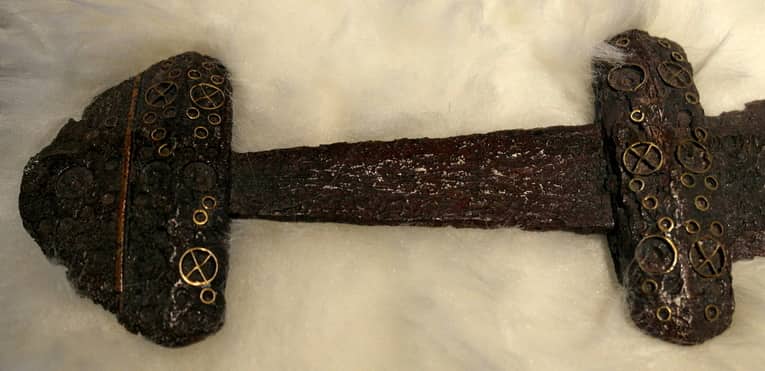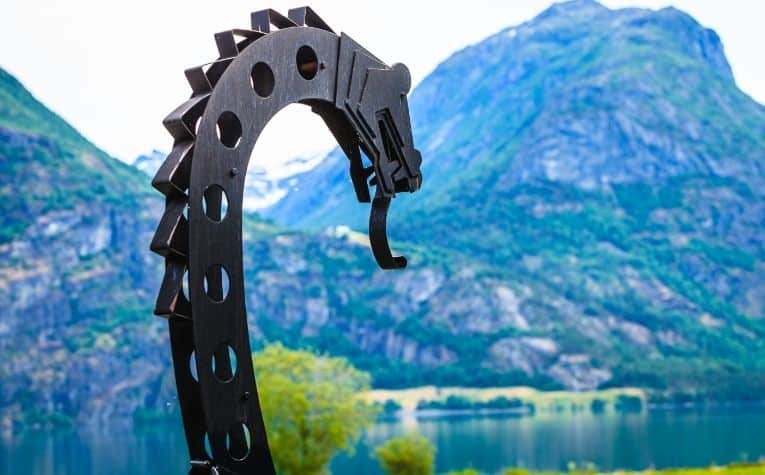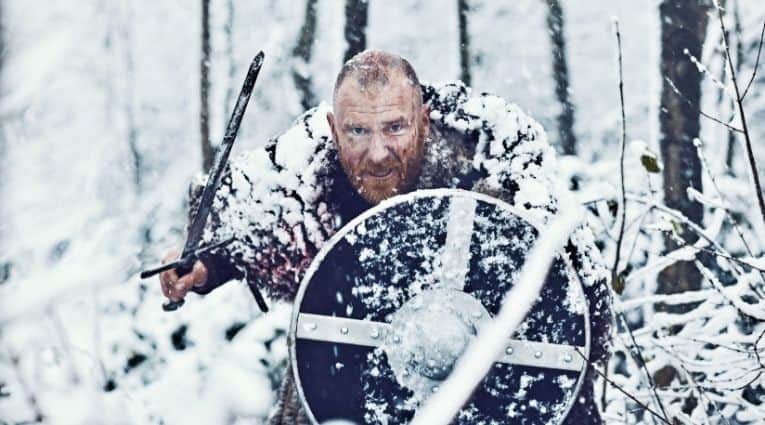The Viking Age lasted just over two and a half centuries, starting near the end of the 8th century and concluding in the middle of the 11th century.
During this time, Viking warriors were the most feared fighting force in all of Europe, and for a good reason.
Aside from their ferocity and fearlessness, they were also expert navigators on the high seas and highly skilled fighters on the field of battle, especially in Britain.
The Vikings invaded Britain for multiple reasons: they saw targets of opportunity; they wanted to capitalize on the disorder in Britain for their regional agenda; they were sometimes paid money for certain conquests; they were applying what they learned about the power of ransom; they were settling land for their own purposes; and they hoped for reward in Valhalla.
A nation that frequently found itself in the crosshairs of Viking raids and military expeditions was Britain, which was just across the North Sea from Denmark and Norway, well within the range of the dreaded Viking longboats.
Although historians’ opinions vary as to the primary motivation for the Vikings concentrating their efforts on the island nation, here are five reasons why they invaded Britain.
A lot of people wonder about Vikings women and the role they played in society. See Did Female Vikings Go on Raids? to learn more.

The Vikings Saw Targets of Opportunity in Britain
The first known Viking raid on English soil took place in June of 793 at an abbey known as Lindisfarne, located on the northeast coastline.
By most accounts, three Viking longboats were seen anchored offshore, and when an unsuspecting attendant went out to aid what he mistakenly believed to be misdirected Norse merchants, he was promptly cut down.
The Viking marauders proceeded to slaughter every living soul, comprised of defenseless and unarmed monks, at the abbey and make off with its trove of riches. (Also see Did the Vikings Fight Samurai?)
Although the brutal sacking of a religious establishment was shocking, and the cold-blooded murders of men of the cloth unthinkable, the Viking attack at Lindisfarne initially had no religious motivation.
It was simply a target of opportunity.
In the years that followed, other abbeys and monasteries along the English coastline were targeted, with their occupants brutally murdered and all valuables taken by Viking raiders.
Through their prior dealings with trade centers throughout Britain, the Vikings observed a constant flow of goods and riches, particularly the lavish gifts that would often be donated to religious orders.
At the dawn of the Viking Age and as the first raids took place, Christianity had not yet spread to the Norse people.
As such, attacking places of worship, killing monks and the like, and stealing their valuables, did not raise any morality issues for the Vikings, who worshiped pagan gods.
Thus, religious sites in Britain became easy targets for quick strikes and instant wealth for the taking. [1]
Swords were important to Viking raiding, but so were shields. See The Viking Shield: Why is it round, wooden & painted? to learn more.

The Vikings Capitalized on Disorder in Britain and Europe
Before engaging in the raids for which they would become feared throughout Northern Europe, the Norse people were active traders.
As Europe began to prosper during the Middle Ages and wealth grew, goods like furs from Scandinavia became popular.
The Vikings recognized opportunities to increase their wealth and power through their exposure to the channels of commerce in Europe.
During the 9th century, much of Europe was gripped in political instability as rival kings grappled with each other for more territory and power.
For instance, in 840, the Frankish ruler Lothar sought Viking military assistance to protect his interests against his power-hungry siblings.
The Vikings found similar circumstances in England as Anglo-Saxon rulers vied against one another while neglecting the greater common threat posed by the Vikings. (Also see Did the Vikings Have Cats?)
Seeing an opportunity to gain a stronghold in Britain, the Vikings mounted waves of invasions and successfully seized territory from English rulers.
Only by the heroic efforts of England’s King Alfred was the territory of Wessex spared from the Viking onslaught.
The Norse invaders occupied and then settled in a large swath of England in the northern part of the country known as “Danelaw,” where a major commerce center, York, emerged. [2]
Do modern depictions accurately portray what the Vikings looked like? See The Viking Dress Code: What They Wore and How to learn more.

The Vikings Were Paid Protection Money
Because of the Vikings’ brutality and the inability of opposition fighting forces to adapt to the quick-strike methods of Viking warriors or to match their fighting prowess, kings and rulers in Europe opted to pay off the Norse invaders, rather than place themselves, their citizens, and their territories, at the mercy of Viking warlords and their warriors.
The payment of Danegeld (“Dane gold”), which was essentially protection money, was a considerable drain on those nations’ resources that made monetary concessions to the Vikings.
One particular English King, Aethelred II, paid so much in Danegeld that he nearly bankrupted his own country.
As word of Danegeld reached other Viking leaders, they too mounted invasions against England and other European nations in search of lucrative opportunities to show up and do nothing. [3]
The Vikings Learned the Power of Ransom
Although the raids on Lindisfarne and other religious sites put all of Europe on notice that even abbeys and monasteries were fair targets for plundering, the Vikings were, above all else, opportunistic when it came to gaining wealth and power.
Items like gold, silver, and other tangible forms of wealth contributed to big paydays for Viking invaders during the peak years of their raiding.
But they were savvy enough to recognize that some treasures were more valuable if they were held for a ransom.
Raids on religious institutions netted the Vikings things like bibles and rare manuscripts.
These items would have been priceless to the impacted parties, and they were willing to pay a steep price for their return.
For example, in Canterbury during the mid-9th century, an English aristocrat paid a ransom with pure gold to secure the return of a religious script known as the Codex Aureus. [4]
The Vikings Settled Their Conquered Lands
As Viking warriors raided and plundered targets along the English coastline and further inland, they found more than opportunities for immediate wealth.
After they brought back to Scandinavia the troves of treasure and valuables taken from abbeys, monasteries, and estates of the wealthy, the Vikings returned to Britain with an eye toward even bigger prizes: land and upward mobility.
Viking raids were initially limited to quick-strike targets directly on the coast.
However, in the years following the attack on Lindisfarne in 793, Norse warriors made their way further inland, in more extensive and more organized numbers.
As these incursions occurred, the open stretches of fertile land caught the eyes of some members of the Viking forces.
In particular, England’s vast and fertile lands would have appealed to the Karls (free people who comprised the middle class of Norse society) who, more likely than not, had zero prospects for land ownership back home in Denmark, Norway, or Sweden.
Even if a warrior’s family were fortunate enough to own land, he would have been last in line as far as any inheritance if he was the last-born son.
Thus, Britain represented an opportunity for Vikings willing to leave the familiar surroundings of their homeland, to start life anew in a country that had a milder climate and plentiful land for farming and raising livestock.
And with the growing population of Viking expatriates in England, there would have been some familiarity with language and customs. [5]
Invading Britain was a Clear Path to Valhalla
The Vikings believed that their deaths were pre-ordained and that their fates on the fields of battle rested with the all-father Odin and his Valkyries.
These Norse warriors were unafraid of death and believed that to fall in the heat of battle was the most honorable way to die and the surest way to spend the afterlife in the great halls of Valhalla, feasting and drinking wine with the gods.
Therefore, the raids on Britain were opportunities for Viking warriors to prove their mettle in the eyes of their commanders and compatriots and demonstrate their worthiness to join Odin’s army for the final battle of Ragnarok. [6]
Conclusion
In their search for wealth and improvement in their lot in life, the Vikings looked to Britain and found a land of opportunity.
References:
[1] https://www.historyhit.com/why-did-the-vikings-invade-britain
[2] https://www.google.com/amp/s/www.history.com/.amp/topics/exploration/vikings-history
[3] https://www.newworldencyclopedia.org/entry/Danegeld
[4] https://www.jorvikvikingcentre.co.uk/the-vikings/where-did-they-come-from/
[6] https://www.ancient.eu/article/1197/viking-raids-in-britain/
